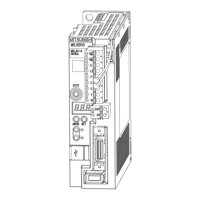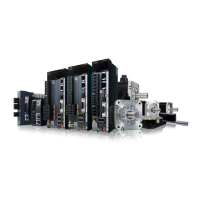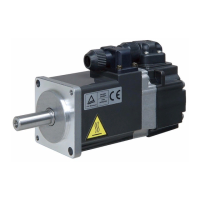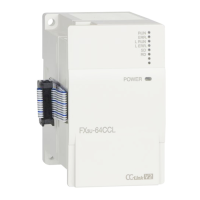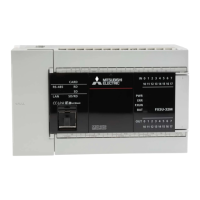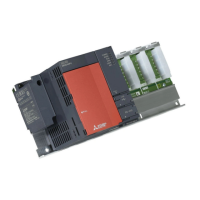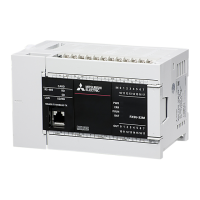4. STARTUP
4 - 8
(2) How to find the cause of position shift
ࠛࡦ
ࠦ࠳
Q
P
C
M
L
(b) ᜰࡄ࡞ࠬ⚥Ⓧ
(c) Ꮻㆶࡄ࡞ࠬ⚥Ⓧ
(d) ᯏᱛ⟎M
(B)
(a) ജࡄ࡞ࠬ
ࠞ࠙ࡦ࠲
(A)
(C) SON(ࠨࡏࠝࡦ)ജ
LSPLSN(ࠬ࠻ࡠࠢࠛࡦ࠼)ജ
ࠨࡏࠕࡦࡊ⟎࡙࠾࠶࠻
ࠨࡏࡕ࠲
ᯏ
㔚ሶࠡࠕ
[Pr.PA05]㧘[Pr.PA06]㧘
[Pr.PA07]㧘[Pr.PA21]
When a position shift occurs, check (a) output pulse counter display, (b) cumulative command pulse, (c)
cumulative feedback pulse, and (d) machine stop position in the above diagram.
(A), (B) and (C) indicate position shift causes. For example, (A) indicates that noise entered the wiring
between positioning unit and servo amplifier, causing pulses to be miss-counted.
In a normal status without position shift, there are the following relationships.
1) Q = P (Output counter of the positioning module = Cumulative command pulses of the servo
amplifier)
2) When [Pr. PA21] is "0 _ _ _"
P •
CMX[Pr.PA06]
CDV[Pr.PA07]
= C (Cumulative command pulses × Electronic gear = Cumulative feedback
pulses)
3) When [Pr. PA21] is "1 _ _ _"
P •
4194304
FBP[Pr.PA05]
= C
4) When [Pr. PA21] is "2 _ _ _"
P •
CMX[Pr.PA06]
CDV[Pr.PA07]
× 16 = C
5) C • ǻ
Ͱ
= M (Cumulative feedback pulses × Travel distance per pulse = Machine position)
Check for a position mismatch in the following sequence.
1) When Q P
Noise entered the pulse train signal wiring between positioning unit and servo amplifier, causing
pulses to be miss-counted. (Cause A)
Make the following check or take the following measures.
Check how the shielding is done.
Change the open collector type to the differential line driver type.
Run wiring away from the power circuit.
Install a data line filter. (Refer to section 11.14 (2) (a).)
Change the [Pr. PA13 Command pulse input form] setting.
Positioning module
(a) Output pulse
counter
Servo amplifier
(C) SON (Servo-on) input
LSP/LSN (Stroke end) input
Electronic gear
[Pr. PA05],[Pr. PA06],
Pr. PA07
,
Pr. PA21
Servo motor
Machine
(d) Machine stop position M
Encoder
(c) Cumulative feedback pulses
(b) Cumulative command pulses
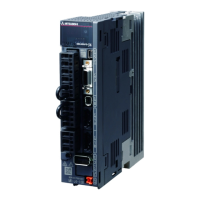
